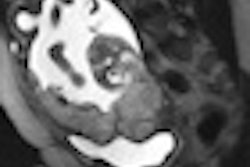A stand-up MRI scanner found signs of lumbar spine compression in children carrying full backpacks, according to researchers from the University of California, San Diego (UCSD) School of Medicine.
Principal investigator Dr. Timothy Neuschwander, a second-year resident in UCSD's department of orthopedic surgery, and colleagues conducted a study measuring lumbar disk compressibility and lumbar spine curvature in children who were wearing filled backpacks. The research was published in the January 1 issue of Spine (2010, Vol. 35:1, pp. 83-88).
Researchers recruited three boys and five girls of average size and weight, ranging in age from 9 to 14, who had no prior history of back pain, scoliosis, or spine surgery. MRI was performed using an MRI scanner capable of scanning patients while standing up (Fonar, Melville, NY).
The children first underwent sagittal T2 scans of the lumbar spine in supine and standing positions, after resting 30 minutes in the supine positions. Then, a dual-strap backpack containing 8.8 lb (4 kg) of ceramic tiles was placed on each child's shoulders, and the sagittal T2 scans were repeated. This procedure was repeated with 17.6 lb (8 kg) and 26.4 lb (12 kg) loads. The loads represented approximately 10%, 20%, and 30% of the body weight of the children.
Increased backpack loads significantly compressed lumbar disk heights measured in the midline sagittal plane, the study authors reported. Mean lumbar asymmetry was 2.23° standing without a backpack, 5.46° wearing an 8.8-lb backpack, 9.18° wearing a 17.6-lb backpack, and 5.68° wearing a 26.4-lb backpack.
Backpack loads also increased lumbar asymmetry. Half of the children had Cobb angles greater than 10° when wearing the 17.6-lb backpack. Five children had a lumbar curve to the right and three to the left, which remained consistent regardless of backpack load.
The authors recommended that future studies be conducted to compare the effects of backpack weight between normal children and those with idiopathic low back pain.
By Cynthia E. Keen
AuntMinnie.com staff writer
January 6, 2010
Copyright © 2010 AuntMinnie.com



.fFmgij6Hin.png?auto=compress%2Cformat&fit=crop&h=100&q=70&w=100)




.fFmgij6Hin.png?auto=compress%2Cformat&fit=crop&h=167&q=70&w=250)











